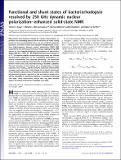Functional and shunt states of bacteriorhodopsin resolved by 250 GHz dynamic nuclear polarization-enhanced solid-state NMR
Author(s)
Bajaj, Vikram S.; Mak-Jurkauskas, Melody L.; Belenky, Marina; Herzfeld, Judith; Griffin, Robert Guy
DownloadBajaj-2009-Functional and shunt.pdf (489.2Kb)
PUBLISHER_POLICY
Publisher Policy
Article is made available in accordance with the publisher's policy and may be subject to US copyright law. Please refer to the publisher's site for terms of use.
Terms of use
Metadata
Show full item recordAbstract
Observation and structural studies of reaction intermediates of proteins are challenging because of the mixtures of states usually present at low concentrations. Here, we use a 250 GHz gyrotron (cyclotron resonance maser) and cryogenic temperatures to perform high-frequency dynamic nuclear polarization (DNP) NMR experiments that enhance sensitivity in magic-angle spinning NMR spectra of cryo-trapped photocycle intermediates of bacteriorhodopsin (bR) by a factor of ≈90. Multidimensional spectroscopy of U-13C,15N-labeled samples resolved coexisting states and allowed chemical shift assignments in the retinylidene chromophore for several intermediates not observed previously. The correlation spectra reveal unexpected heterogeneity in dark-adapted bR, distortion in the K state, and, most importantly, 4 discrete L substates. Thermal relaxation of the mixture of L's showed that 3 of these substates revert to bR568 and that only the 1 substate with both the strongest counterion and a fully relaxed 13-cis bond is functional. These definitive observations of functional and shunt states in the bR photocycle provide a preview of the mechanistic insights that will be accessible in membrane proteins via sensitivity-enhanced DNP NMR. These observations would have not been possible absent the signal enhancement available from DNP.
Date issued
2009-06Department
Massachusetts Institute of Technology. Department of Chemistry; Francis Bitter Magnet Laboratory (Massachusetts Institute of Technology)Journal
Proceedings of the National Academy of Sciences of the United States of America
Publisher
National Academy of Sciences
Citation
Bajaj, Vikram S. et al. “Functional and shunt states of bacteriorhodopsin resolved by 250 GHz dynamic nuclear polarization–enhanced solid-state NMR.” Proceedings of the National Academy of Sciences 106.23 (2009): 9244-9249. © 2009 the National Academy of Sciences
Version: Final published version
ISSN
0027-8424
Keywords
magic-angle spinning, photocycle intermediate, retinal protein, ion transport, DNP